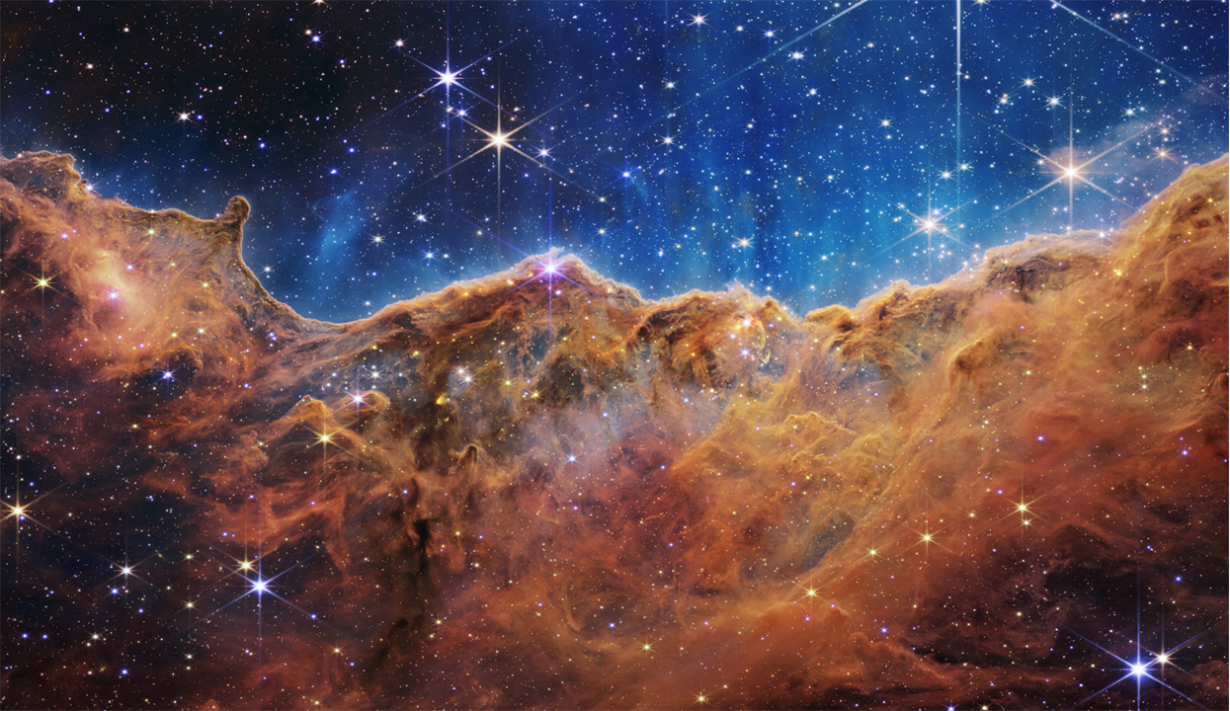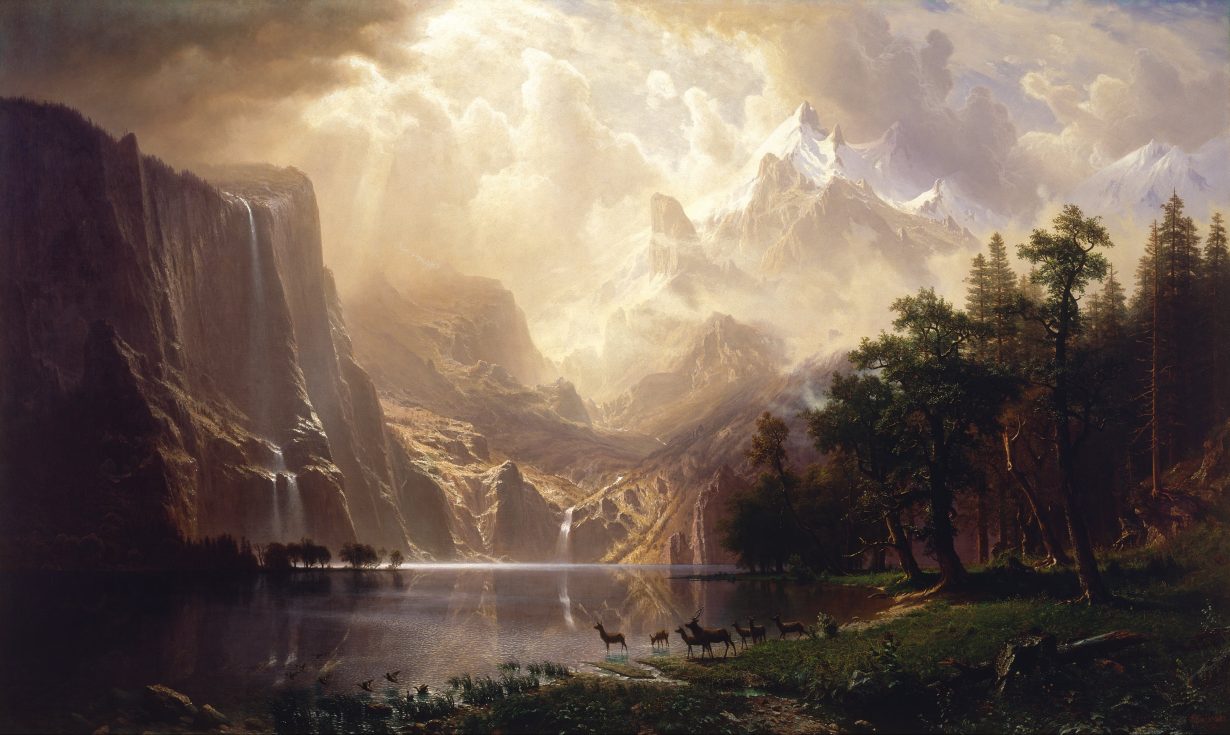There is a whole process of subjective choice – and aesthetic messaging – that shapes the way we see the furthest points of deep space
Last week NASA published the first images taken by the James Webb Space Telescope. Launched from French Guiana on Christmas Day 2021, Webb is now over a million miles from Earth and stationed permanently in our planet’s shadow to protect the sensitive instrumentation from the light and heat of the Sun.
Webb was designed as a replacement for the venerable Hubble (launched in 1990 and which has long out-performed its initial lifetime of fifteen years), but in many ways it’s a completely different beast. Because Webb’s mirror is far larger than its predecessor, it can observe much fainter objects and operates primarily at infra-red wavelengths, way beyond the scope of what we can see with our eyes or detect with ground-based telescopes on the Earth’s surface. Detections of infra-red light are essential in telling us about possible signs of life around other planets, the formation of stars and the make-up of the most distant galaxies in the Universe.
But because we can’t see what Webb has detected, its data has to be translated to visible light. The original detections are arrays of numbers recorded on a digital camera and converted to greyscale. These greyscale images are taken at different wavelengths which are then each assigned a colour, before being combined into a multi-colour image. There is a subjective choice in deciding which visible colour might correspond to each infra-red wavelength, but this choice is not apparent in the final, much publicised pictures. Joseph DePasquale leads a whole team at NASA dedicated to this endeavour, using, in his words, ‘art and aesthetics to prepare astronomical data for the creation of press-quality imagery’. There is even a name for its colour scheme: the Hubble Palette. When we look at the Carina Nebula, for example, and its accompanying cloud of gas in which young stars are forming, we see complex structures depicted in browns and blues – perhaps rather familiar shades that remind us of terrestrial landscapes. This image has been oriented so that the brown structures might suggest land, and the blue ones the sky. NASA’s accompanying text also encourages us to make this connection; ‘Called the Cosmic Cliffs, Webb’s seemingly three-dimensional picture looks like craggy mountains on a moonlit evening… This landscape of “mountains” and “valleys” speckled with glittering stars is actually the edge of a nearby, young, star-forming region…’


The Stanford art historian Elizabeth Kessler has written about the way in which Hubble’s images (also initially greyscale) were manipulated in a way that evokes the palette of nineteenth century paintings of the American West by artists such as Albert Bierstadt and Winslow Homer – this art attempted to convey the overwhelming scale and size of the new frontier to people who’d never laid eyes on it. This was art that prompted the sublime, and Hubble’s images have the same effect.

The Webb images are clearly continuing in this attempt to create a specific aesthetic. Perhaps NASA is hoping that these images will become as iconic as, say, the Hubble’s ‘Pillars of Creation’, released in 1995. And because we have had nearly three decades to become familiar with this portrayal of outer space, we no longer consider how the technology works. It has rendered itself invisible, the flawless Webb images creating the illusion that we are seeing things with our own naked eyes, adhering to our visual and aesthetic expectations. This in turn also reinforces the heroic aspect of our astronomy – it’s us alone facing the mighty and awesome cosmos; the last and largest frontier, and we’re able to understand it with our human-sized technology. In contrast to the apparent perfection of the Webb pictures, the 2019 images taken by the Event Horizon Telescope of a black hole in a nearby galaxy, which were also a stupendous feat of technology, were actually criticised by some pundits for being ‘blurry’.

The images from Webb show the Universe not as we actually see it, but as we might hope to see it. It’s wildly better than our own views of the night sky, which are all too often degraded by light pollution, bad weather and artificial satellites. The Webb image of the galaxy cluster SMACS 0723 is crowded with more distant galaxies photobombing the main target; the Universe is revealed to be swimming with galaxies: oval, spiral, smooth, ruptured, distorted, isolated and interacting in groups. The varied shapes, sizes, and colours give them the air of organic material. We are immersed in a cosmic sea of information and the darkness of the night sky is increasingly revealed to be an illusion, caused by our inability to view more than a narrow window of what the Universe offers.

This piece of sky captured in Webb’s ‘First Deep Field’ is physically minute (Hubble has produced many similar ‘deep fields’, albeit none of them as detailed as this). In NASA’s words, it’s as small as a grain of sand held at arm’s length. We are simultaneously being confronted with the galaxies’ incredible and incomprehensible distances from us – that of billions of lightyears – and their microscopic appearance. Galaxies are vast; our own Milky Way spans more than a hundred thousand lightyears across. But for us to be able to see and understand such distant galaxies, they have to be inverted in dimension, rendering them as small as biological cells.
Because the light emitted by these galaxies takes so long to travel to us, when we look at these images we’re looking back in time. The distant galaxies don’t share a ‘now’ moment with us; they’re irretrievably fixed in the past, their images as spectral as sepia tinted photographs of long-dead relatives whose names are inked along the edges; ‘Großmutter Klara’; ‘Galaxy Cluster’. We talk about the birth and death of stars, for this is the only way we can know the Universe – by coming face to face with its ghosts.
